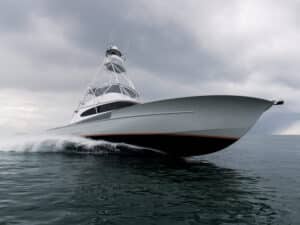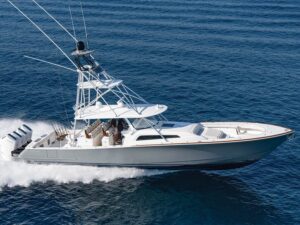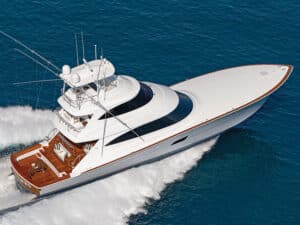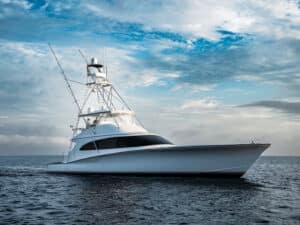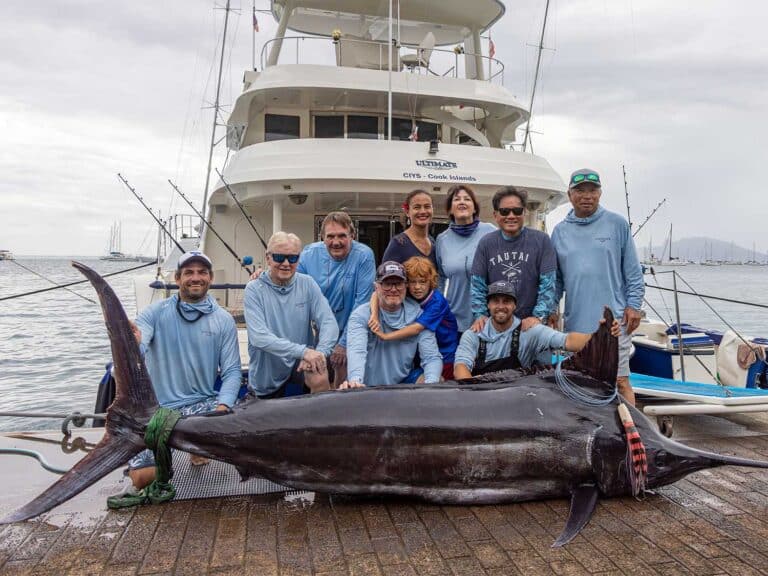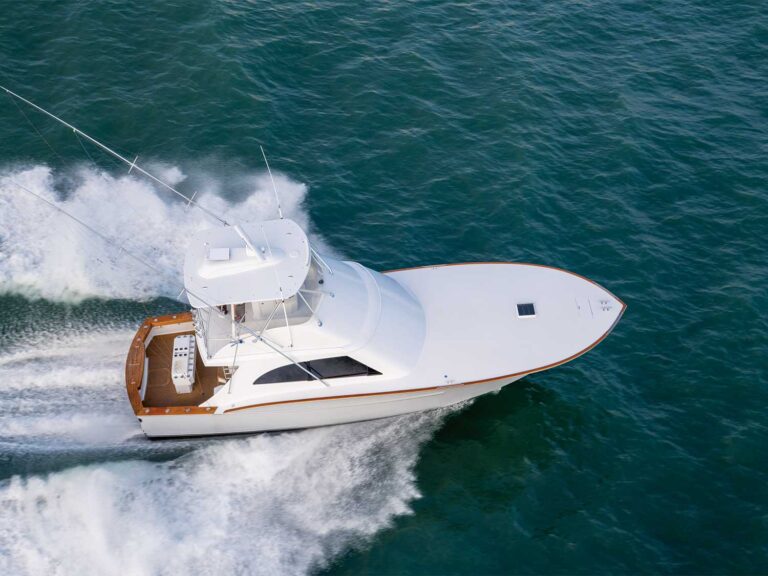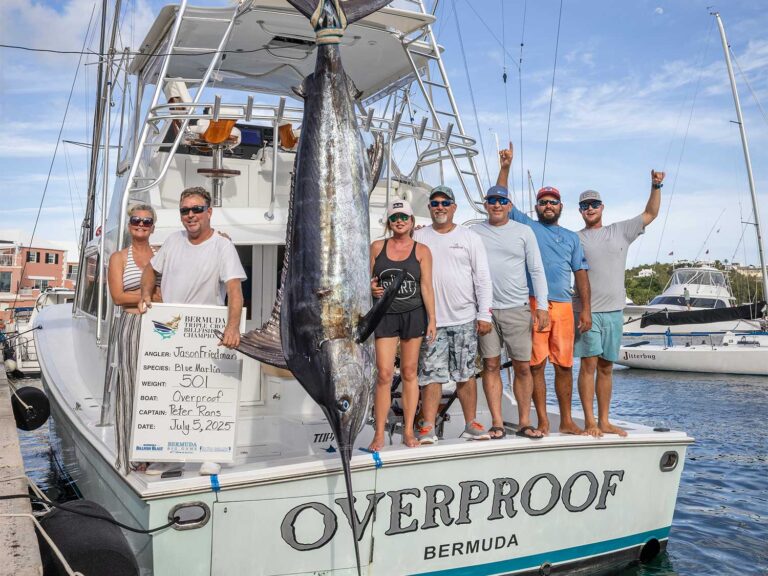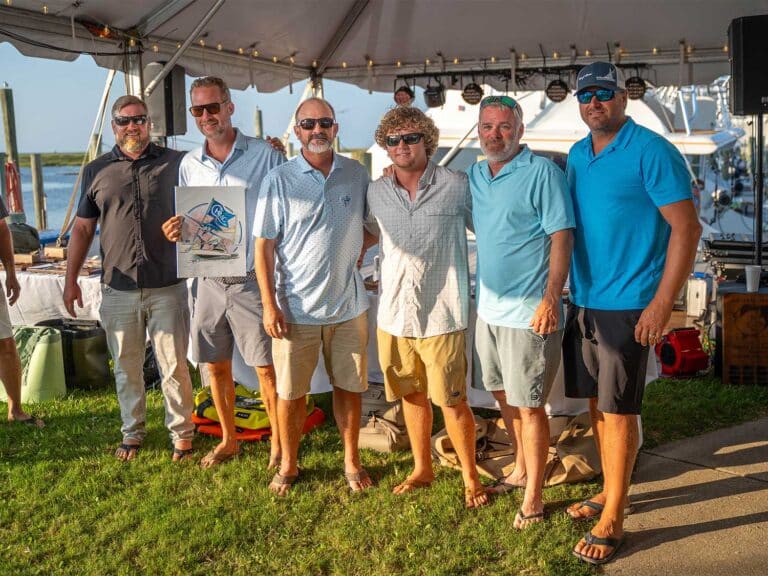Viking Yachts has, in its three newest models, embarked on a journey into truly advanced technology, design and construction. Each new model employs refinements gleaned from the last model. So to say that each new boat Viking builds is the best it’s ever built is no exaggeration. The company’s goal is perfection, and although there’s never been a perfect boat, Viking gets a little closer with each new model.
The 65’s entire hull is end-grain balsa composite. Even the stringers are now foam filled except under the engines. Amazingly, the new 65’s hull weighs a scant 1,000 pounds heavier than the Viking 58s. Styling has changed a bit. You’ll see more crown on the foredeck and flybridge, fewer sharp corners and more soft, radius turns. Frameless windows even have a crown in them to soften the lines.
Performance
Fore and aft vision for the helmsman is the best you’ll find anywhere on this size boat, thanks to the placement of the helm and the notched cutout in the flybridge coaming forward.
The wheel turns like silk; you’ll experience an immediate response, and small, incremental course changes can be accomplished remarkably quickly. However, turn the wheel hard over and the 65 banks gently, scribing a large arc that doesn’t decrease your speed.
Backing down at 6.5 knots in total control, I couldn’t get any water at all to enter the cockpit through the scuppers, tuna door or over the cap rail. Looking at the scupper from the inside, I have no doubt that any water that might gather in the cockpit wouldn’t be there for very long.
To make a boat this size go fast takes impressive power. Our test boat packed twin 16-cylinder, 2000 series DDC/MTUs into the engine compartment. Each engine produces 1,800 hp at the peak of the torque curve. Top speed according to two GPS units proved an impressive 39 knots. But a far more economical 34-knot cruising speed seemed very comfortable while still cooking right along. Looking from alongside, the 65 appears to run with a very modest bow inclination. But as with most high-speed large convertibles, there’s actually a fair bit of hull lifting out of the water. At cruising speed, the ocean meets the hull right about amidships.
Fishability
Needless to say, the large cockpit of any 65-footer provides more than enough room for multiple anglers to fish side by side without crowding. But the first impression of the Viking 65’s cockpit inspires minimalist awe. It’s so clean it borders on stark. Gaffs, mops and the like stow efficiently under the side walkways, as do the hose and shore power cable. Viking has molded in a ledge or step along the forward edge of the cockpit where cleaning supplies, fish, drinks, bait and anything else can be stored unobtrusively. An additional step up to the salon door contains a refrigerated drink cooler. The cabinetry along the salon bulkhead also contains the obligatory rigging station, sink, tackle drawers, etc.
After about an hour’s cruise out to the tuna grounds, I discovered another terrific aspect of the 65’s cockpit. Viking has tapered the back ends of the cabin sides toward the center of the boat, effectively channeling air into the cockpit. This totally eliminates any “station-wagon” effect from the exhaust, leaving not a speck of spray to besmirch the salon’s cockpit window. All those anglers who regularly sit atop the cockpit cabinetry underway will particularly appreciate it.
There must have been a hundred boats out in one fairly small area fishing for giant bluefin tuna. During our day of fishing, we raised, caught and released a 100-pounder. As far as I could see (or hear on the radio), we were the only boat to catch a fish that day. That certainly speaks well for our boat’s fish-raising ability. Oh, and reaching over the gunwale to remove the hook and revive the bluefin proved a comfortable and well-balanced reach.
While pulling tuna spreader rigs at a 3- to 4-knot trolling speed, I detected absolutely no discernable wake turbulence. The spreader bars generated far more white water than the boat did. At 8 knots the prop wash was solid through the first wave aft, but still I saw no chine turbulence.
I know there was a time when hardcore anglers swore that no boat over 40 feet long could fish effectively. They obviously never fished a Viking 65. It doesn’t matter what maneuvers you perform to catch a fish; this boat will back, spin and run responsively enough to match even the fastest big game.
Altogether, I can think of only one change I’d ask the factory to make if I were buying a new 65. Despite the exceptionally good nonskid on the bow, there’s a space between the cabin sides and the foredeck where, if you’re walking forward to anchor, there isn’t adequate handhold security. Sure, adding a handrail may disrupt the lines slightly, but I’d rather do that than fall overboard.
Flybridge
Air-conditioning evaporators have been moved from the bridge, where most builders put them, to down inside the boat. This freed up a ton of space for additional rod storage on the flybridge. A big refrigerated drink box assures you’ll only need to make one beverage trip per day to your belowdecks storage.
I like several noteworthy features about this flybridge. First, you could get everyone aboard seated topside for evening harbor cruises and still not be crowded. Second, the helm has plenty of room behind it to move across the bridge to the guest helm seat. Third, a Plexiglas insert in the forward flybridge coaming affords the helmsman a wonderfully clear view of the bow for anchoring and docking.
Interior
The Viking 65 comes in two accommodation layouts. A three-cabin arrangement provides a study in lieu of crew’s quarters aft for those who want to live aboard or take extended trips without sacrificing shore-side business. A four-cabin layout features two cabins with large beds and two others with over/under bunks. Both layouts provide a private head for each cabin.
All the A/C comes out behind the window valances in the salon so you have no ugly vents in the overhead. Even the air intakes have been hidden in the stairwell below.
Viking has finished the 65 impeccably with gloss-finished teak throughout. At first the galley appears to be bare counter space, but you’ll find hidden drawers containing the refrigerators and freezers, a three-burner electric stove, microwave, dishwasher and all the other appliances.
Engine Room
The Viking 65 not only provides ample width through the cockpit access hatch but full standing headroom in the compartment. The extra cabin between the engine room and the master stateroom provides a healthy noise buffer.
As in the cockpit, the word stark comes to mind in the engine room. Systems that need frequent maintenance are positioned conveniently, as are all switches. Additionally, you’ll find plenty of storage space for tools and spares.
